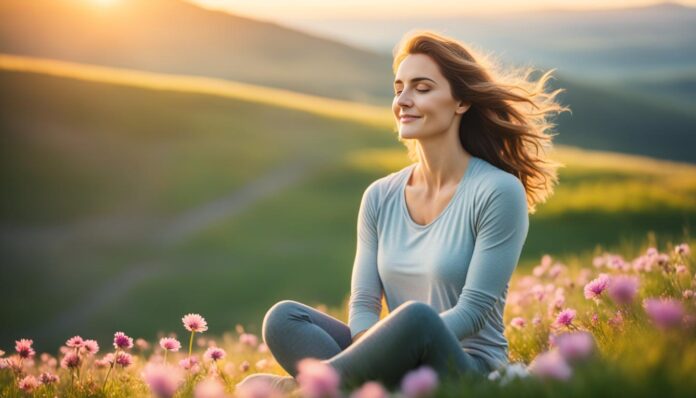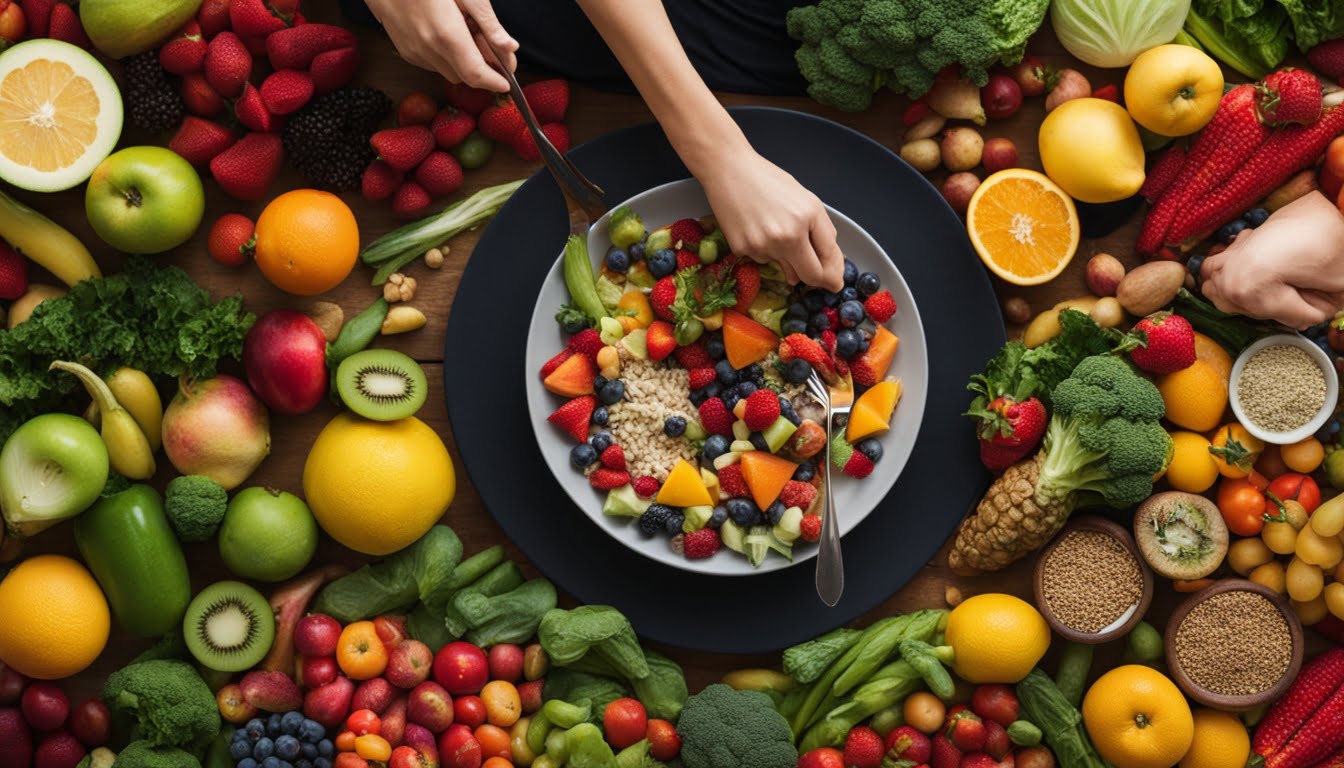
About 75% of women feel bad about their bodies because of society’s beauty standards. This shows how important it is to accept our bodies. We need to see our own beauty and value our uniqueness. Loving ourselves helps us feel emotionally strong.
On this path, we can think about our experiences and take steps to accept ourselves. By loving ourselves and being kind, we get better mental and physical health. We become more confident and have happier relationships.
Key Takeaways
- Understanding and embracing body acceptance can significantly improve mental health.
- Societal pressures influence feelings of inadequacy and negative body image.
- Practicing self-compassion can reduce negative body image thoughts by up to 50%.
- Surrounding ourselves with body-positive media can boost self-esteem.
- Building a community that celebrates diverse body shapes is essential for self-acceptance.
- Focusing on well-being rather than appearance enhances overall happiness and life satisfaction.
The Importance of Body Acceptance in Today’s Society
In today’s world, we face many pressures that shape how we see ourselves and our bodies. These come from the media, which shows us idealized images and beauty standards that are hard to reach. This can make it tough to have a good view of ourselves, leading to feelings of not being good enough.
To fight these negative effects, we need to understand the value of accepting our bodies. We must build a culture that values body positivity.
Understanding Societal Pressures
Society’s pressures deeply affect how we see our bodies. Studies show that over half of girls and nearly a third of boys want a thinner body shape. This shows early signs of not being happy with their bodies.
Feeling bad about one’s body can lead to low self-esteem and increase the risk of depression and anxiety. This highlights the need to promote body acceptance to fight against societal expectations.
Impact of Unrealistic Beauty Standards
Beauty standards that are not realistic, pushed by the media, lead to more body image issues and mental health problems. Women often feel more depression because of how they feel about their looks. The body positivity movement tries to change this by accepting all body types.
It also shows how important it is to accept our bodies for our mental health. By changing beauty standards, we can make a place where everyone feels good in their own skin.
| Research Findings | Implications |
|---|---|
| 50.5% of girls desire a thinner body shape | Early signs of body dissatisfaction |
| Higher depression rates in women | Link between body dissatisfaction and gender disparities |
| Body dissatisfaction linked to anxiety in adolescents | Need for improved body acceptance strategies |
| Increasing body positivity movement | Promotion of diverse representations in beauty standards |
Challenging Beauty Standards
Let’s start a conversation about beauty on our own terms. We need to see beauty as a wide range of things. By celebrating different body types, we create a world that values everyone’s beauty.
Defining What Beauty Means to Us
Beauty isn’t just about looking a certain way. It’s about letting everyone express themselves. We can do this by sharing our stories, supporting diverse media, and accepting our unique looks. Beauty should love our flaws and differences, helping us all find our own way to express ourselves.
Recognizing Diversity in Body Types
We need to see the many body types out there. This helps us move past old beauty standards. By celebrating all body types, we lift up those who have been left out. We work towards a fashion and beauty world that includes everyone. This way, everyone feels good in their own skin.
| Beauty Ideal | Consequences | Alternative Approach |
|---|---|---|
| Slimness | Body shaming, unhealthy behaviors | Celebrate all body sizes |
| Fair Skin | Colorism, low self-esteem | Embrace all skin tones |
| Youthfulness | Age-related insecurities | Value all ages and experiences |
The Role of Self-Love in Body Acceptance
Self-love is key to accepting our bodies. It helps us be kind to ourselves, which builds a better relationship with our bodies. We learn to be gentle with ourselves, especially when we feel insecure.
Self-compassion means stopping negative thoughts and using positive affirmations instead. These affirmations boost our self-worth and remind us of our true value.
Practicing Self-Compassion
Self-love starts with self-compassion. It means understanding that everyone has different struggles with body image. By being kind to ourselves, we fight against harmful societal ideas.
We focus on our strengths and celebrate being unique. Mindfulness and journaling help us accept ourselves more deeply. They help us deal with the pressures we face.
Creating Affirmations for Self-Worth
Creating affirmations is a big part of building self-worth. These should match our personal experiences and values. For instance, we might say, “I am enough just as I am,” or “My worth is not defined by societal expectations.”
Using affirmations often helps us stay positive and fight against negative opinions. As we grow in self-love through these words, our overall well-being improves. This leads to better mental and emotional health.

Embracing Curves and Different Body Types
On our path to self-acceptance, it’s key to embrace curves and various body types. We celebrate body diversity to empower people. We encourage everyone to love their unique shapes and sizes, not just fit into narrow standards.
Through body positivity, we see a change in how beauty is seen. We believe all body types deserve respect and recognition.
Celebrating Body Diversity
Seeing and valuing body diversity makes everyone feel more important. By showing different body types, we broaden our view of beauty. This leads to more diverse representation in media and fashion.
This celebration fights against biases. It shows that beauty doesn’t fit one mold. Letting go of old ideas helps us support others and ourselves.
Understanding Body Positivity Movements
Body positivity movements push for everyone to be included. They ask us to question old beauty standards. This challenges harmful stereotypes, especially for people with higher body mass indexes.
Women often face discrimination at work because of their size. Movements like Health At Every Size (HAES) promote a healthier view of body image. They stress the need to respect all body types.
Body Neutrality: A Different Approach
Exploring body neutrality shows us a new way that goes alongside body positivity. It’s an alternative focus on how our bodies work, not just how they look. This view helps us see our bodies as capable, promoting self-acceptance without the need to always love or hate them.
What is Body Neutrality?
Body neutrality started around 2015 for those who didn’t fit into the body positivity movement. It’s about seeing our bodies as functional, not just pretty. This shift helps us drop societal beauty standards, letting us celebrate our bodies for what they can do.
With 83% of women and 74% of men unhappy with their looks, many find self-acceptance through neutrality appealing. It’s about accepting ourselves without getting caught up in love or hate. This approach helps our mental health and reduces beauty pressure.
Body neutrality doesn’t replace body positivity. It just acknowledges that sometimes, feeling good about our bodies is hard. By accepting ourselves neutrally, we improve our relationship with our bodies. This way, we focus on caring for ourselves fully, leading to better body image discussions and our well-being.
Intuitive Eating and the Anti-Diet Culture
We’re turning to intuitive eating to better understand food and our bodies. This method helps us listen to our hunger signals. It moves us away from the guilt of diet culture towards mindful eating.
Understanding Intuitive Eating Principles
Intuitive eating is based on several key ideas. These ideas help us trust ourselves and our bodies. They include:
- Rejecting the diet mentality
- Honoring hunger
- Making peace with food
- Challenging the food police
- Respecting fullness
- Discovering the satisfaction factor
- Learning to feel your emotions without using food
- Respecting your body
- Movement—feel the difference
- Nourishment—build trust
These principles help us avoid restrictive eating. They stand against the anti-diet culture, which pushes for impossible body types and unhealthy habits. Intuitive eating lets us see food as nourishment, not just a way to fit into society.
Rejecting Diet Culture for Healthy Living
It’s key to reject diet culture for a healthier life. Most people who diet end up heavier than before. But those who eat intuitively might be healthier over time.
A 2005 study showed that women in a Health at Every Size (HAES) program were healthier than those on traditional diets. This supports a move towards accepting all body types and promoting healthy living.

| Study Year | Focus | Findings |
|---|---|---|
| 2011 | Diet Rebound | Most dieters regain weight, with many regaining more than lost |
| 2005 | HAES Program | Participants focusing on intuitive eating had better health after two years |
| 2017+ | Social Media | Use of #bodypositivity often showcases thin individuals, impacting body acceptance |
By choosing intuitive eating, we learn to be kind to ourselves and our bodies. Saying no to diet culture improves our relationship with food. It leads to a healthier life through self-acceptance and mindful eating.
Practicing Health at Every Size (HAES)
The Health at Every Size (HAES) movement tells us to focus on health, not just weight. It’s about creating a supportive space for everyone, no matter their size. This approach helps us all feel good without worrying about fitting into certain body types.
Supporting Size Inclusivity
Size inclusivity means everyone gets the same healthcare and wellness support. Sadly, 76% of obese people face weight bias from doctors and nurses. We need to fight this and make sure everyone gets the care they deserve, no matter their size. By promoting a healthy mindset, we can overcome these biases and build a more welcoming society.
Fostering a Healthy Mindset about All Body Sizes
Having a positive view of body sizes is crucial for well-being. HAES teaches us to respect all body types and focus on living a fulfilling life. Research shows that HAES can really improve mental health, eating habits, and overall health for many people. This approach boosts self-acceptance and self-esteem, too.
Steps Toward Cultivating a Positive Body Image
Creating a positive body image takes effort and awareness. We can begin by choosing to surround positivity every day. Being around supportive groups and uplifting content changes how we see ourselves.
Surrounding Ourselves with Positivity
Being with positive people boosts our confidence and helps us accept ourselves. We can:
- Join groups that focus on body positivity and acceptance.
- Limit exposure to negative media that sets bad beauty standards.
- Compliment others to build a culture of appreciation and positivity.
- Celebrate diversity in body types and enjoy media that shows realistic beauty.
Engaging in Mindfulness Practices
Mindfulness practices are key to changing our thoughts. By noticing negative thoughts without judging them, we make room for positive change. Techniques like meditation, deep breathing, and self-reflection help us:
- Challenge negative thoughts by questioning their truth.
- Focus on our strengths instead of societal beauty ideals.
- Practice self-compassion, understanding that everyone is imperfect.
- Be thankful for our bodies and what they do for us.
By combining these methods, we can build a better and healthier relationship with our bodies. This improves our mental health and our connections with others. Embracing a positive body image makes us feel better overall.
Conclusion
Embracing body acceptance is a key journey we all must take. We need to challenge societal norms and unrealistic beauty standards. This creates a place where everyone’s authenticity and diversity are valued.
Our journey to self-acceptance is more than just saying yes to ourselves. It’s about growing self-love. This means celebrating bodies of all shapes, sizes, and backgrounds.
It’s important to understand the challenges faced by marginalized bodies. Studies show how often certain body types are shown in media. We must work to make body positivity more inclusive for BIPOC, LGBTQAI+, and people with different abilities.
We can change our culture by giving a platform to diverse voices. This helps change how beauty is seen and valued.
Let’s inspire others to start their own journey to self-acceptance. The path may be hard, but it leads to a fulfilling life filled with compassion and understanding. Together, we can create a world where every body is valued and everyone feels included.
FAQ
What is body acceptance and why is it important?
Body acceptance means loving and accepting our unique looks. It’s key for our mental health and happiness. It fights against harmful beauty ideals, making us feel better about ourselves.
How can we challenge beauty standards?
We can challenge beauty standards by setting our own beauty goals. Celebrating all body types helps create a world that values everyone, no matter their size or shape.
What role does self-love play in body acceptance?
Self-love is the base of body acceptance. It means being kind to ourselves, fighting negative thoughts, and seeing our worth. This leads to deeper love and happiness with our bodies.
What does it mean to embrace curves?
Embracing curves is about loving our unique bodies. It’s about not trying to fit into narrow beauty ideals. This supports the body positivity movement, pushing for more body diversity.
How does intuitive eating relate to body acceptance?
Intuitive eating means listening to our bodies and not following strict diets. It builds a healthy relationship with food, teaching us to trust and care for ourselves. This fits well with body acceptance.
What is the Health at Every Size (HAES) approach?
HAES believes health comes in all sizes and supports size diversity. It focuses on well-being, not weight loss. This lets people enjoy healthy living without worrying about body shape.
How can we cultivate a positive body image?
A positive body image comes from being around supportive people and media that values diversity. Mindfulness helps us notice negative thoughts without getting caught up in them. This builds self-awareness and acceptance.
